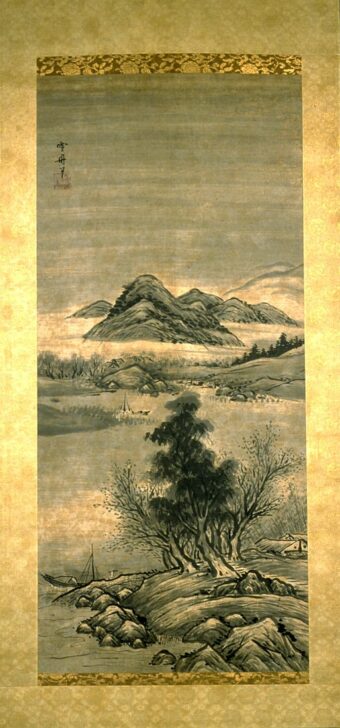Summer Landscape (pair with Winter Landscape, 1970/2.151)
Sesshū Tōyō

Description
Sesshū Tōyō
Japan, 1420-1506
Summer Landscape (right)
Winter Landscape (left)
Sengoku period (1490–1573)
Late 15th century–early 16th century
Hanging scroll, ink on paper
Museum purchase made possible by the Margaret Watson Parker Art
Collection Fund, 1970/2.150–151
Sesshu’s reputation as an artist of extraordinary abilities has remained
undiminished in Japan for five centuries. Born in a small town on
Japan’s Inland Sea, he moved to Kyoto to become a Zen monk. Sesshu’s
style changed dramatically after a three-year sojourn in Ming dynasty
(1368–1644) China in the 1460s. There he studied with court painters,
prominent literati (amateur scholar-artist) painters, and Zen monks.
He also made detailed sketches of famous paintings of the Song
(969–1279) and Yuan (1271–1368) dynasties. Upon his return to Japan, he
developed his own style, freely incorporating elements from both the
paintings and the grand scenery he had seen in China.
These two paintings are part of a triptych (a set of three paintings)
handed down in the collection of the Kuroda family, lords of a major
domain in western Japan, near the area where Sesshu spent the last
part of his life. Scholars disagree about whether the artist’s signature
and seal are authentic, and thus whether the painting is truly by
Sesshu. But even if it is not by Sesshu himself, it is by an artist or
assistant closely associated with him and thus is representative of his
late style, which is characterized by bold, exuberant brushwork.
Summer 2022 Gallery Rotation
__________
Sesshū Tōyō
Japan, 1420-1506
Summer Landscape (right)
Winter Landscape (left)
Sengoku period (1490–1573)
Late 15th century–early 16th century
Hanging scroll, ink on paper
Museum purchase made possible by the Margaret Watson Parker Art
Collection Fund, 1970/2.150–151
Sesshu’s reputation as an artist of extraordinary abilities has remained
undiminished in Japan for five centuries. Born in a small town on
Japan’s Inland Sea, he moved to Kyoto to become a Zen monk. Sesshu’s
style changed dramatically after a three-year sojourn in Ming dynasty
(1368–1644) China in the 1460s. There he studied with court painters,
prominent literati (amateur scholar-artist) painters, and Zen monks.
He also made detailed sketches of famous paintings of the Song
(969–1279) and Yuan (1271–1368) dynasties. Upon his return to Japan, he
developed his own style, freely incorporating elements from both the
paintings and the grand scenery he had seen in China.
These two paintings are part of a triptych (a set of three paintings)
handed down in the collection of the Kuroda family, lords of a major
domain in western Japan, near the area where Sesshu spent the last
part of his life. Scholars disagree about whether the artist’s signature
and seal are authentic, and thus whether the painting is truly by
Sesshu. But even if it is not by Sesshu himself, it is by an artist or
assistant closely associated with him and thus is representative of his
late style, which is characterized by bold, exuberant brushwork.
Summer 2022 Gallery Rotation
__________
Attributed to Sesshu ̄ To ̄yo ̄
Japan, 1420–1506
Summer Landscape (right)
Winter Landscape (left)
Muromachi period (1333–1573)
Late 15th century–early 16th century
Hanging scroll, ink on paper
Museum purchase made possible by the Margaret Watson Parker Art Collection Fund, 1970/2.150 & 151
Sesshu ̄’s reputation as an artist of extraordinary abilities has remained undiminished in Japan for five centuries. Born
in a small town on Japan’s Inland Sea, he moved to Kyoto
to become a Zen monk. There he became a painter after encountering Shu ̄bun, then the preeminent master of ink landscapes in Japan. Sesshu ̄’s style changed dramatically after a three-year sojourn in Ming China in the 1460s, where he studied with court painters, prominent literati (amateur scholar-artist) painters, and Zen monks. He also made detailed sketches of famous earlier paintings of the Song (969–1279) and Yuan (1271–1368) dynasties. Upon his return to Japan, he developed his own style, freely incorporating elements from both the paintings and the grand scenery he had seen in China.
These two paintings are part of a triptych (a set of three paintings) handed down in the collection of the Kuroda family, lords of a major domain in western Japan, near the area where Sesshu ̄ spent the last part of his life. Scholars disagree about whether the artist’s signature and seal
are authentic, and thus whether the painting is truly by Sesshu ̄. But even if it is not by Sesshu ̄ himself, it is by an artist or assistant closely associated with him, and thus is representative of his late style, characterized by bold, exuberant brushwork.
Subject Matter:
This hanging scroll is one of a pair that was handed down in the collection of the Kuroda family, lords of a major domain in western Japan, near the area where Sesshû spent the last part of his life. It may be an image of a small fishing village in summer.
Physical Description:
A small figure is shown near a ship on the water. A building or house is partially hidden by hills. Trees, mountains, and clouds are strewn across the landscape with bold brishwork.
Usage Rights:
If you are interested in using an image for a publication, please visit https://umma.umich.edu/request-image/ for more information and to fill out the online Image Rights and Reproductions Request Form.